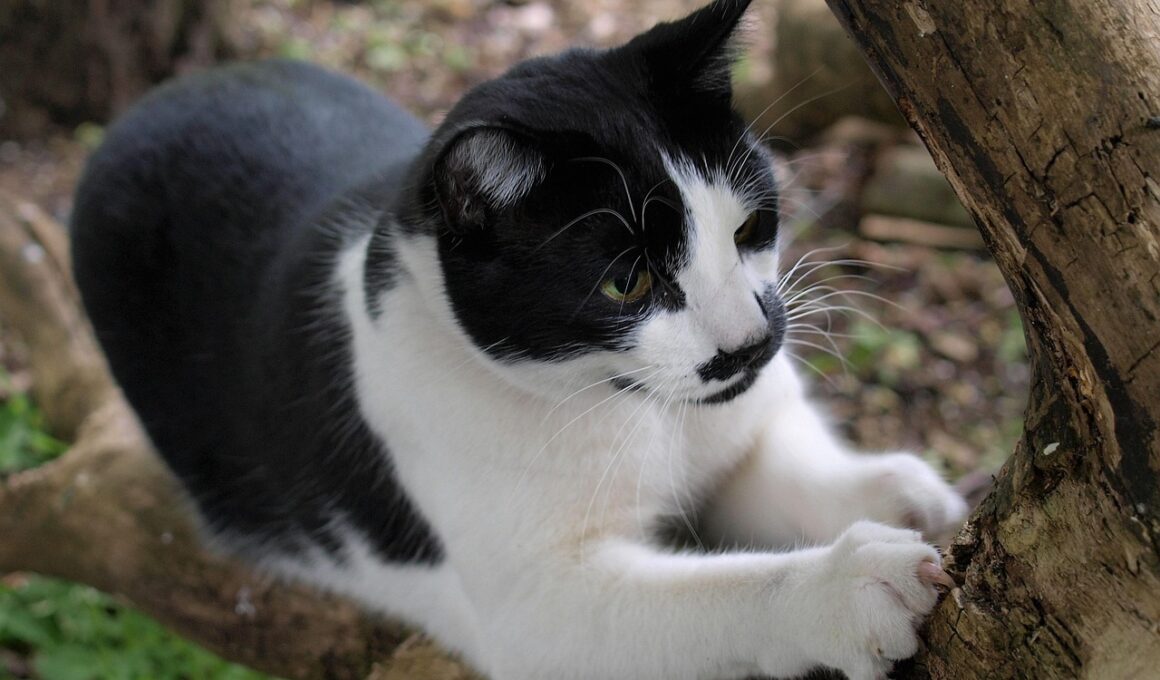Natural Remedies to Soothe Cats That Scratch Excessively
Excessive scratching can become an irritating habit for both cats and their owners. Understanding the underlying causes of excessive scratching is crucial in addressing the issue effectively. Some reasons for this behavior might include stress, anxiety, or even discomfort caused by underlying health issues. If a cat scratches excessively, it may be reacting to perceived threats in its environment. In some cases, it could also be bored and seeking attention. The first step towards finding remedies involves observing your cat’s behavior closely. Assess their environment and routine for potential stressors. Once the triggers are identified, explore natural remedies that can help soothe their anxiety or frustration. Simple environmental modifications can encourage your cat to feel safe and relaxed. Apart from making the physical space comfortable, consider incorporating more playtime or interactive toys to engage your cat mentally. Additionally, helping your feline friend to express natural scratching behaviors through appropriate scratching posts can be beneficial. These steps can create a more secure environment while mitigating unwanted scratching behaviors. Remember to be patient, as changing a cat’s behavior often requires time and consistency.
Creating a scratching-friendly space involves more than just placing a scratching post. Cats prefer particular types of materials when it comes to scratching surfaces. To determine what your cat likes best, experiment with different textures such as cardboard, sisal, or carpet. Establishing multiple scratching stations can further help mitigate excessive scratching on people. These areas should be placed strategically in locations where the cat spends time, enticing them to use those surfaces instead of their human companions. Encouraging the use of these areas may require introducing enticing elements, such as catnip or toys, to attract your pet. Another crucial factor is adopting a consistent training approach. Whenever your cat chooses the post over scratching on your skin, you should reward them with praise or treats. By reinforcing positive behavior, your cat learns that scratching the post results in positive outcomes. Moreover, taking note of your cat’s favorite spot to scratch can help in positioning the posts appropriately. This creates a direct association between their natural behavior and the appropriate outlet. When implemented effectively, these strategies can enhance your relationship with your furry friend while reducing scratching incidents.
Herbal Remedies as Calming Agents
Herbal remedies can provide calming effects for your feline friend, significantly reducing anxiety and stress levels that contribute to excessive scratching. Many natural herbal supplements are available, which may help soothe an anxious cat. Popular choices among cat owners include valerian root and chamomile. These herbs can be integrated into your cat’s daily routine through treats or tinctures. Additionally, essential oils like lavender are known for their calming properties. However, it is crucial to ensure that these are used safely, as some oils can be toxic to cats. Always dilute essential oils before application, and consult a veterinarian before trying any new supplement or remedy. You can also consider incorporating calming pheromone sprays or diffusers in your home. These synthetic pheromones can create a sense of security, helping to reduce anxiety triggers. Moreover, the creation of a calming environment can be essential, ensuring that your living space is serene and free from sudden loud noises. By establishing a peaceful atmosphere, your cat will feel secure which can help diminish scratching behavior. The combination of herbal remedies and environmental modifications can be powerful in curbing excess scratching.
Incorporating engaging activities into your cat’s daily routine can significantly reduce boredom-induced scratching. Interactive playtime is essential for mental stimulation, allowing cats to express their natural predatory instincts. Dedicate time each day to engage with your cat through play, using feather wands or laser pointers to encourage exercise. Rotate toys regularly to keep their interest piqued and prevent overstimulation from the same toys. Scratching posts can also be turned into playtime opportunities if you attach dangling toys for your cat to swipe at. Another beneficial activity is puzzle feeders, which stimulate your cat both physically and mentally while delivering treats or meals. This combination of food and fun can help redirect their energy towards acceptable behaviors. Additionally, consider forming a routine to provide structure in your cat’s day. Cats, like humans, thrive on routines, which can offer them security. Properly structured playtimes can significantly lessen anxiety, which might be a contributing factor to excessive scratching. By ensuring your cat has enough physical and mental stimulation, you can help cats that scratch excessively feel calmer and more focused on appropriate activities.
Enrichment Through Environment
Environmental enrichment is vital for a cat’s well-being; it encourages exploration, play, and reduces anxiety that may lead to unwanted scratching. Consider creating more vertically accessible spaces, such as cat trees or shelves, to satisfy your cat’s instinct to observe from heights. Cats often feel more secure when they have vantage points where they can watch their surroundings. Also, taking time to rotate toys and scratching surfaces reduces impulse scratching by keeping your cat engaged and stimulated. Adding safe hiding spots, such as boxes or tunnels, opens avenues for playful exploration and relaxation. If you have multiple cats, ensure that resources like food bowls, litter boxes, and scratching posts are adequately provided to prevent competition and stress. As part of their enrichment strategy, provide safe outdoor access via a catio or supervised walks to expose your cat to fresh air and natural stimuli. Regular interactions with humans also play a key role in reducing anxiety. Ultimately, by prioritizing environmental enrichment, cat owners can foster a more enjoyable and fulfilling life for their feline companions, helping to alleviate excessive scratching problems effectively.
Regular grooming is another natural remedy that can reduce a cat’s need to scratch excessively. Grooming not only helps remove loose fur and dirt but also offers an opportunity for bonding. Many cats thrive on physical contact, so a regular grooming session can be very comforting for them. Additionally, matting in a cat’s fur can be uncomfortable, leading to scratching and irritation. By maintaining their fur, you can significantly reduce the odds of your cat scratching excessively due to discomfort. Moreover, regular grooming helps in monitoring your cat’s overall health, allowing you to spot irritations or skin conditions early on. Use a suitable brush that caters to your cat’s coat type, investing time to develop a grooming routine that your cat enjoys. Provide treats as a reward during grooming sessions to create positive associations. Over time, your cat may come to anticipate and enjoy grooming, which may help alleviate stress. Furthermore, by promoting regular grooming habits, both you and your cat can bond while addressing behavior issues comprehensively. Developing this habit also contributes to creating a loving and supportive environment for your furry friend.
When to Seek Professional Help
Despite your efforts to manage excessive scratching through the suggested natural remedies, some cases may still require professional intervention. Cats exhibiting severe stress, anxiety, or compulsive scratching behaviors may benefit from a consultation with a veterinarian or animal behaviorist. The expert can evaluate to rule out underlying medical conditions contributing to the behavior, such as allergies or skin disorders. If psychological factors are determined, they may suggest behavior modification techniques tailored to suit your cat’s needs. In some cases, prescription medication may be advised to help alleviate extreme anxiety levels if behavioral strategies alone prove ineffective. Documentation of your cat’s behavior patterns can be beneficial during consultations; keep notes on when the scratching occurs, alongside any changes in their routine or environment. This can provide valuable insights to the professionals assessing your cat’s condition. Additionally, don’t hesitate to discuss incorporating more holistic approaches such as acupuncture or specialized diets. Seeking professional help can be a transformative step in helping your cat feel more secure and less prone to excessive scratching, ensuring they lead a more balanced and happy life.
In conclusion, addressing excessive scratching in cats requires a combination of natural remedies and behavioral adjustments. The first step involves identifying the underlying causes, whether they be physical or psychological. Implementing environmental modifications, engaging in interactive playtime, and utilizing herbal remedies can make a significant difference in your cat’s behavior. Creating an enriching environment for your cat ensures they feel secure, engaged, and less likely to resort to excessive scratching. Additionally, incorporating regular grooming helps maintain your cat’s hygiene, potentially reducing discomfort that leads to scratching. If needed, professional assistance should not be overlooked when the situation demands specialized attention. Together, all these strategies can create a holistic approach to enhancing your cat’s emotional well-being. Always keep an open line of communication with your veterinarian to discuss ongoing concerns or shifting behaviors. By taking the time to attend to your cat’s needs holistically, you can ensure a harmonious relationship free from excessive scratching issues, ultimately enriching the life for both you and your furry companion.


